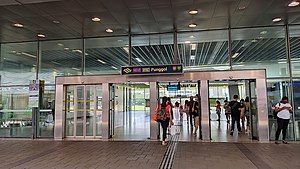
The Mass Rapid Transit system, locally known by the initialism MRT, is a rapid transit system in Singapore and the island country's principal mode of railway transportation. The system commenced operations in November 1987 after two decades of planning with an initial 6 km (3.7 mi) stretch consisting of five stations. The network has since grown to span the length and breadth of the country's main island – with the exception of the forested core and the rural northwestern region – in accordance with Singapore's aim of developing a comprehensive rail network as the backbone of the country's public transportation system, averaging a daily ridership of 3.4 million in 2019.

The North East Line (NEL) is a high-capacity Mass Rapid Transit (MRT) line in Singapore. Operated by SBS Transit, the 20-kilometre (12 mi) line is the MRT's shortest. It runs from HarbourFront station in southern Singapore to Punggol station in the northeast, serving 16 stations via Chinatown, Little India, Serangoon and Hougang. Coloured purple on official maps, it is Singapore's third MRT line and the world's first fully-automated underground driverless heavy rail line.

The Punggol LRT is an automated guideway transit line in Singapore. The line, which initially opened on 29 January 2005, connects the residential districts and suburbs of Punggol to Punggol Town Centre, where it connects with the North East MRT line and the Punggol Bus Interchange. It is the third line of the LRT system in Singapore and like all other LRT lines, it is fully elevated and uses automated trains.

The Sengkang LRT is a 10.7-kilometre (6.6 mi) automated guideway transit line in Singapore. The line, which initially opened on 18 January 2003, connects the residential districts and suburbs of Sengkang to Sengkang Town Centre, where it connects with the North East MRT line, Sengkang Bus Interchange, Compass One and Compassvale Bus Interchange. It is the second line of the LRT system in Singapore and like all other LRT lines, it is fully elevated and uses automated trains. It is the first LRT line to be operated by SBS Transit.

Outram Park MRT station is an underground Mass Rapid Transit (MRT) interchange station in Singapore. The station is on the East–West, North East and Thomson–East Coast lines, and is located near the junction of Outram Road, Eu Tong Sen Street and New Bridge Road on the boundary of Bukit Merah and Outram planning areas. It is the closest MRT station to Singapore General Hospital, the Police Cantonment Complex, Outram Community Hospital and the Health Promotion Board. The station was included in the early plans of the MRT network in 1982; it was constructed as part of the Phase I MRT segment from Novena, and was completed in December 1987.

Dhoby Ghaut MRT station is an underground Mass Rapid Transit (MRT) interchange station on the North South, North East and Circle lines in Singapore. Located beneath the eastern end of Orchard Road shopping belt in Dhoby Ghaut, Museum Planning Area, the station is integrated with the commercial development The Atrium@Orchard. The station is near landmarks such as The Istana, the MacDonald House, Plaza Singapura and Dhoby Ghaut Green.
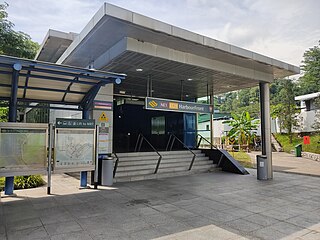
HarbourFront MRT station is an underground Mass Rapid Transit (MRT) interchange station in Singapore. The termini of the North East line (NEL) and Circle line (CCL), the station serves the HarbourFront area and Sentosa. Surrounding retail and commercial developments include VivoCity and HarbourFront Centre, and the station is near HarbourFront Bus Interchange and the Singapore Cruise Centre.

Pasir Ris MRT station is an elevated Mass Rapid Transit (MRT) station on the East West line (EWL) in Pasir Ris, Singapore. Situated along Pasir Ris Central adjacent to Pasir Ris Bus Interchange and the White Sands Shopping Mall, it is the eastern terminus of the EWL and, as of June 2021, the only MRT station within Pasir Ris. The station exterior has the characteristic dome-shaped segmented roof also seen on other elevated EWL stations.
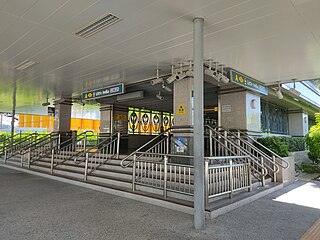
Little India MRT station is an underground Mass Rapid Transit (MRT) interchange station on the North East (NEL) and Downtown (DTL) lines. The station is located at the junction of Bukit Timah Road and Race Course Road, on the boundary of the planning areas of Kallang and Rochor, Singapore.

The Light Rail Transit (LRT) is a series of localised automated guideway transit systems acting as feeder services to the heavy rail Mass Rapid Transit, which together forms the core of Singapore's rail transport services. The first LRT line was opened in 1999 and the system has since expanded to three lines, each serving a new town, namely Bukit Panjang LRT line, Sengkang LRT line and Punggol LRT line. Trains on these lines have at least one station interchange link to the MRT.

Tampines MRT station is a Mass Rapid Transit (MRT) interchange station on the East West (EWL) and Downtown (DTL) lines in Tampines, Singapore. Located in the heart of the Tampines town centre next to Tampines Avenue 4, Tampines Central 4 and Tampines Central 5, it is in close proximity to the Tampines and Tampines Concourse bus interchanges. The station also serves the surrounding retail developments of Tampines Mall, Tampines One and Century Square.
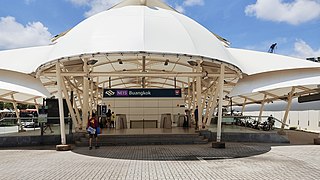
Buangkok MRT station is an underground Mass Rapid Transit (MRT) station on the North East line (NEL) in Singapore. Located underneath Sengkang Central near the junction with Compassvale Bow, the station serves the residential town of Buangkok. The station will also serve an upcoming integrated development Sengkang Grand Residencies and a future bus interchange. The station is operated by SBS Transit.

Potong Pasir MRT station is an underground Mass Rapid Transit (MRT) station on the North East line (NEL) in Toa Payoh planning area, Singapore. It is situated underneath Upper Serangoon Road at the junction with Potong Pasir Avenue 1 and Wan Tho Avenue. Primarily serving the Potong Pasir residential estate, Potong Pasir station is also close to Saint Andrew's Village, a major cluster of educational institutions that are part of the Saint Andrew's family of schools.
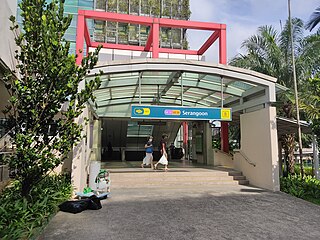
Serangoon MRT station is an underground Mass Rapid Transit (MRT) interchange station on the North East (NEL) and Circle (CCL) lines. Situated in Serangoon, Singapore along Upper Serangoon Road and Serangoon Central, the station is integrated with the Nex shopping complex and the Serangoon Bus Interchange. The station is near the Serangoon Neighbourhood Police Centre and Braddell Heights Community Hub and serves various residential estates in the area.

Kovan MRT station is an underground Mass Rapid Transit (MRT) station on the North East line (NEL) in Hougang, Singapore. Located underneath Upper Serangoon Road, the station serves the retail development of Heartland Mall and surrounding public and private residences.
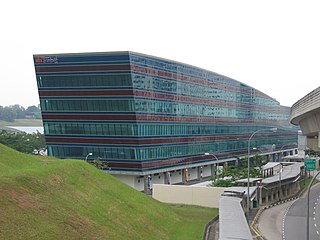
Sengkang Depot is a train depot in Sengkang, Singapore operated by SBS Transit. It is the first co-location of facilities for both the Mass Rapid Transit (MRT) and Light Rail Transit (LRT). It maintains the trains for the North East line, Sengkang LRT line, and Punggol LRT line, and houses the control centre of the three lines.

Sengkang is a planning area and residential town located in the North-East Region of Singapore. The town is the second most populous in the region, being home to 249,370 residents in 2020. Sengkang shares boundaries with Seletar and Punggol in the north, Pasir Ris and Paya Lebar in the east, Hougang and Serangoon to the south, as well as Yishun and Ang Mo Kio to the west.

Riviera LRT station is an elevated Light Rail Transit (LRT) station in Punggol, Singapore. Serving the east loop of the Punggol LRT line (PGLRT), the station is along Punggol East between the junctions of Punggol Central and Punggol Field. Surrounding landmarks include Punggol Joint Temple and Punggol Promenade Riverside Park.

The North-East Region of Singapore is one of the five regions in the country. The region is the most densely populated and has the highest population among the five, with Sengkang being its most populous town as of 2020 and Seletar as the regional centre. Comprising 13,810 hectares, it includes seven planning areas and is largely a residential region with 217,120 homes. Housing largely consists of high-density HDB public housing estates, however private housing is also present in the region. As its name implies, it is located in the north-eastern part of Singapore.

Sengkang MRT/LRT station is a Mass Rapid Transit (MRT) and Light Rail Transit (LRT) interchange station in Sengkang, Singapore. It is an interchange between the North East line (NEL) and Sengkang LRT (SKLRT). Along with Buangkok station, it is located within the Sengkang planning area.
